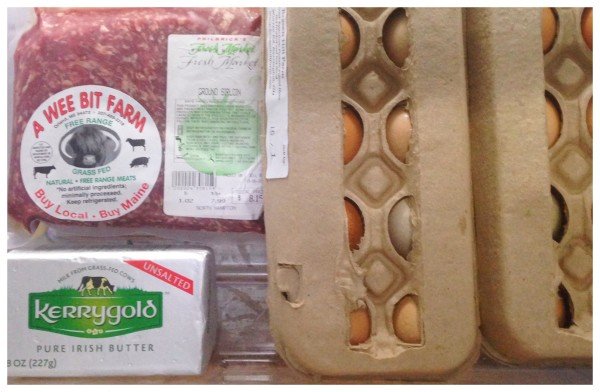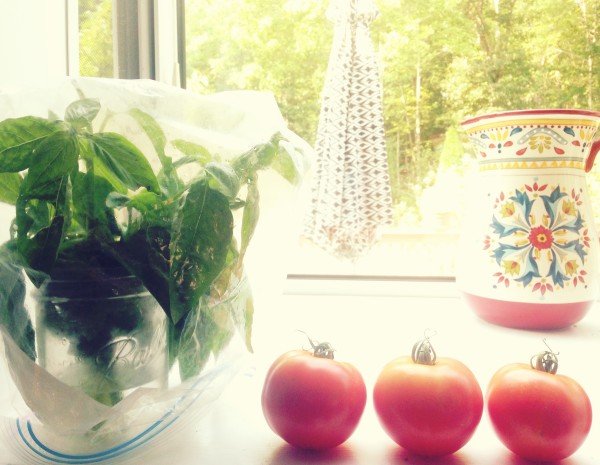Take a Peek Inside a Nutritionist’s Kitchen
We're ready for a reboot at Homestead Holt. While summer doesn't officially end until September 22 (our anniversary!), the week after Labor Day marks the start of fall for many of us. Fun is over, time to get back on track (read: stop housing rosé on the reg).
We're planning to run through a cycle of my Eat to Achieve program, so I made sure we were properly stocked up. I'd say about 70% of healthy living is being prepared. For our food, I typically rotate between the farm by my house (Brasen Hill), Tendercrop Farm, farmers markets, health food stores, Trader Joe's, and big box grocery stores like Hannaford. I will also order some dry goods online at Amazon Prime and Thrive Market.
I've included some Amazon links here, but a lot of these products can be found at Thrive Market for a DEEP discount. I've been asked about my opinion of Thrive, and here it is: I highly recommend it. Thrive is an online market that sells natural and organic food, body care and kitchen products at wholesale prices (think Whole Foods meets Costco meets Amazon). Like Costco, you pay a yearly membership fee of $59.95. I'll tell you that I more than made up for that with my first purchase alone. For every membership fee paid, Thrive donates a membership to a low-income family. They offer a free 30-day membership trial, and you save 15% off your first purchase. I definitely recommend at least browsing through their selection of products to see their low (really, really low) prices.
I'm often asked about the types of foods I regularly keep on hand, so here you have it....
Here’s what a nutritionist’s kitchen looks like on a typical week.
In the Eat to Achieve program, I offer up more details about specific brands that I like, what ingredients to look for, what ingredients to stay away from, and why. If you're looking for more information, I strongly suggest signing up for this 21 day online nutrition program.
THE CUPBOARD
I either buy nuts, seeds, and shredded coconut in bulk at the bulk section of the health food store, or buy bags at Trader Joe's. Nuts and seeds contain polyunsaturated fats, which can go rancid upon storage (when exposed to light, air or heat). I have definitely purchased nuts that seemed "off" in the past. From experience (I used to work there!), I know that the Portsmouth Health Food Center has a high turnover for their bulk items, so their nuts/seeds are always fresh. I find the quality of Trader Joe's nuts to be good, too. I store some in the cupboard for easy access, and then keep some in the freezer to preserve for longer. I always buy raw nuts and seeds.
You can also see the Vital Proteins gelatin powder I use here. I've written about why I like gelatin and its uses, try Inflammation-Busting, Gut-Loving Smoothie Bowl.
That blue bin contains bags of beans and grains that I use less often.
The next shelf has a lot of tea. Loose leaf and boxed. I always buy organic boxed tea—my two favorite brands are Traditional Medicinals and Yogi. I like to buy loose leaf tea in bulk.
You can also see chaga mushrooms and dried elderberries—I make tea from the mushrooms by boiling them in water, and make syrup from the elderberries to take daily during cold and flu season.
We've always got Larabars, they are one of the few snack bars that I like. I eat dark chocolate just about every night after supper. I always buy organic and fair trade.
Also pictured: almond butter and peanut butter. There are only two ingredients in my nut butters: the nut itself and salt. No sweeteners, no added oils of any kind. 98% of the time I get nut butters in glass containers. Fat promotes the leaching of plastic chemicals—since nut butters are high in fat, I steer clear of plastic containers. Having said that, I happened to grab these at Trader Joe's and they were in plastic. I think it's important to keep in mind that the poison is in the dose. Meaning, making a less-than-ideal choice once in a blue moon isn't the end of the world. It's what you do most of the time that counts!
Here we've got dried fruit (apples, cranberries, dates, raisins, cherries); kale chips (my favorite snack); cricket flour (I use it for homemade protein bars); cacao powder; back up supply of coconut oil and olive oil (ALWAYS buy oils in glass); olives; basmati rice; sardines.
A note on the canned tomato paste: I always buy Muir Glen organic canned tomatoes because they come in a BPA-free can (and are delicious).
Seaweed: I buy kombu to cook my beans and grains (drop a strip into the cook water). This adds minerals and enhances digestion. This is a great brand.
Tigernuts: these aren't nuts, but are little root veggies that are dried. The texture is kind of like a cross between a nut and dried fruit. They are naturally pretty sweet and make a good addition to healthy trail mix.
More gelatin and collagen. I use this for smoothies, baked goods, macaroons, Fuel Bites, protein snack bars and balls. I use the collagen peptides more frequently. I recommend collagen peptides from pasture-raised grass-fed cows, and brands that practice ethical and sustainable sourcing. (Podcast episode on this here.)
While I'm pretty sensitive to dairy, I sometimes add whey protein to my husband's smoothies. A lot of whey protein powders are really crappy. If you like supplementing with whey protein, I would be sure you're getting it from a grass-fed source. Here are some good brands: Wild Whey, SFH, Tera's Grassfed Whey.
Another of my favorite snack bars: eXo bars. They are made with cricket flour, a sustainable protein source. Nothing to be scared of, I promise! These bars are SO tasty! Cacao Nut is my favorite flavor.
My current everyday supplements include Cod Liver Oil, grass-fed liver capsules, magnesium, digestive enzymes. I get asked about fish oil a lot—this is the brand I recommend, for quality and sustainability purposes.
THE FRIDGE
I try to keep a pitcher of infused water in the fridge. Using a large glass dispenser like this, I add citrus slices, herbs and/or cucumbers. I am sure to empty it out every few days, or else it starts to taste scuzzy. Here you also see a couple of heads of curly green kale and fennel. We go through lots and lots of greens each week: I put them in our smoothies (my daughter drinks at least one green smoothie a day—a GREAT way to get greens into your kids!—I use this container to give it to her), I sauté them, I use them for salads, I add them to soups. I'd say we go through at least 6 heads of greens each week (kale, Swiss chard, collards, lettuce, spinach, etc.)
Next shelf: olives, organic strawberries, and chopped up roasted sweet potato. I always have some type of roasted root veggies in the fridge—I make them in a big batch and serve them with eggs in the morning, top salads with them for lunch, and feed them to my daughter.
There's also an organic rotisserie chicken here—sometimes I will pick one up for a quick lunch. I will say it is a lot more cost effective to buy your own chicken and roast it! When purchasing chicken, I always get pasture-raised chicken. Keep in mind that chickens are NOT vegetarians, so if you're buying chicken or eggs that say "vegetarian-fed" you know something's amiss.
Eggs from the farm; grass-fed ground hamburger; butter from grass-fed cows. I typically buy local butter, but Kerrygold is a great option, as it is affordable and can be found in most markets.
(I've got more grass-fed meat, pasture-raised chicken breast and thighs, and pasture-raised bacon in the freezer.)
More produce, plus some short-cuts—broccoli stalk slaw and packaged (pre-boiled) beets. I prefer the Love Beets brand to Trader Joe's because they do organic beets.
That woody looking thing in the top photo is yuca root—I bought it to make pizza dough and will definitely be stocking it regularly. If you are looking for a yummy gluten-free, grain-free pizza crust, you've got to try this recipe!
Top shelf: cold brew coffee concentrate, kombucha scobies, water kefir starter and water bottles. I fill up old kombucha bottles to keep cold bottled water on the ready.
On the door: probiotics (this brand), yogurt starter culture that I use to make coconut yogurt, dry rosé, some soaked and dried nuts/seeds. Soaking nuts and seeds makes them easier to digest, but it's best to store them in the fridge or freezer.
Condiments: Annie's organic ketchup, Bragg's apple cider vinegar, Bragg's liquid aminos, coconut aminos, Veganaise (not the healthiest stuff on earth, but it's tasty and we don't use it too often), wheat-free tamari, whole grain and spicy mustards. Not pictured are fermented veggies. I eat those every day!
THE FREEZER
As mentioned before, I've got a back stock of meat in the fridge. I try buy a bunch of meat 2-4 times a month—I either buy it frozen at the farm, or freeze it myself. It's just easier for me this way than trying to figure out meals last minute. The best way to defrost any type of meat is a slow defrost—pull it out of the freezer and put it into the fridge. It takes a couple of days to thaw out, so plan accordingly. This is the best way from a food safety standpoint. (Don't worry, you guys...I had to get ServSafe certified in school.)
I've got bones in the freezer to make bone broth. I've found the cheapest way to get bones from pasture-raised animals is at farmers markets. You can also get them from a butcher, but make sure your source is good. (I also have mason jars of broth in my freezer, as well.)
Another thing I keep for broth: veggie scraps. You know when you're chopping veggies and have all the ends—like onions, carrots, celery, really anything? You could throw them out (worst option), compost them (great option), or freeze them (my favorite choice). When you're ready to make broth—chicken or another bone broth, or even veggie broth—toss all the frozen veggie bits in a large pot with water and salt. So easy, it tastes SO much better than store bought.
Also in the freezer: a bunch of frozen berries and fruit that I use for smoothies. We have 18 blueberry bushes in our yard, so I stockpiled them this summer and froze a bunch. The best way to freeze berries: spread them out in a single layer on a baking sheet. Freeze them like this, then transfer into storage bags or bins. If you skip the first step, they will all stick together (think of a bag of ice).
I also keep a back up of nuts and seeds and nut flours (like almond flour and coconut flour) in the freezer for longer keeping.
THE COUNTER
This is all pretty self-explanatory. Organic everything except for the lemons because they weren't available. That means I won't be using the zest of these lemons—I only do that with organic citrus. The tomatoes are from the garden—the only thing that's left (because my husband took them over...I killed off everything else...).
Here's a great tip for basil: it doesn't like the cold, so don't store it in the fridge. When you get home, put it in a container or glass with water, then cover with a plastic storage bag. This creates a little greenhouse, and your basil will last much longer!
There you have it, folks! Keep the questions coming on Instagram! And tag me in pics of your kitchen!









